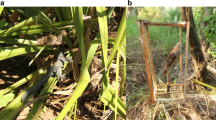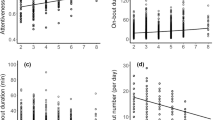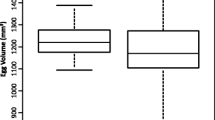Summary
Observations were made of ten green (red-billed) woodhoopoe Phoeniculus purpureus flocks during the breeding season in order to quantify the relationship between flock size and the amount of food delivered to chicks. The study period was kept short specifically to minimize the effects of environmental stochasticity. Neither woodhoopoe feeding visit rates nor the total amount of food brought to chicks increased with flock size. Although nonbreeders did not increase the net rate of food provisioning to chicks, they reduced parental input in chick rearing, and hence energy expenditure by the breeding pair. However, over an 8-year study period, which includes data for 144 flock years, this did not result in increased breeding frequency or enhanced survival of breeders. There is thus no evidence that helpers' feeding contributions to young per se influence the indirect fitness of helpers.
Similar content being viewed by others
References
Austad SN, Rabenold KN (1985) Reproductive enhancement by helpers and an experimental enquiry into its mechanism in the Bicolored Wren. Behav Ecol Sociobiol 17:19–27
Brown JL (1987) Helping and communal breeding in birds: ecology and evolution. Princeton University Press, Princeton
Brown JL, Dow DD, Brown ER, Brown SD (1978) Effects of helpers on feeding of nestlings in the grey-crowned babbler (Pamatostomus temporalis). Behav Ecol Sociobiol 4:43–59
Clarke ME (1984) Co-operative breeding by the Australian bell miner Manorina melanophrys Latham: a test of kin selection theory. Behav Ecol Sociobiol 14:137–146
Earle RA (1983) Aspects of the breeding biology of the white-browed sparrow-weaver Plocepasser mahali (Aves: Ploceidae). Navorsinge van die Nasionale Museum 4:177–191
Emlen ST (1984) Cooperative breeding in birds and mammals. In: Krebs JR, Davies NB (eds) Behavioural ecology: an evolutionary approach. Sinauer, Sunderland MA, pp 305–339
Fry CH (1978) Phoeniculidae. In: Snow DE (ed) An atlas of speciation in African non-passerine birds. Scolar Press, West Yorkshire, pp 316–318
Gaston AJ (1973) The ecology and behaviour of the long-tailed tit. Ibis 115:330–351
Hamilton WD (1964) The genetical evolution of social behaviour. J Theor Biol 7:1–52
Hunter LA (1987) Cooperative breeding in purple gallinules: the role of helpers in feeding chicks. Behav Ecol Sociobiol 20:171–177
Koenig WD, Mumme RL (1987) Population ecology of the cooperatively breeding acorn woodpecker. Princeton University Press, Princeton
Lewis DM (1982) Cooperative breeding in a population of white-crowned sparrow-weavers plocepasser mahali. Ibis 124:511–522
Ligon JD (1981) Demographic patterns and communal breeding in the green woodhoopoe, Phoeniculus purpureus. In: Alexander RD, Tinkle DW (eds) Natural selection and social behaviour. Chiron Press, New York, pp 231–243
Ligon JD (1983) Cooperation and reciprocity in avian social systems. Am Nat 121:366–384
Ligon JD, Ligon SH (1978) The communal social system of the green woodhoopoe in Kenya. Living Bird 17:159–197
Ligon JD, Ligon SH (1990) Green woodhoopoes: life history traits and sociality. In: Stacey PB, Koenig WD (eds) Cooperative breeding in birds: long-term studies of ecology and behaviour. Cambridge University Press, New York, pp 31–65
McGowan KJ, Woolfenden GE (1990) Contributions to fledgling feeding in the Florida scrub jay. J Anim Ecol 59:691–707
Mumme RL (1984) Competition and cooperation in the communally breeding acorn woodpecker. PhD dissertation. University of California, Berkeley
Parry V (1973) The auxiliary social system and its effect on territory and breeding in kookaburras. Emu 73:81–100
Plessis MA du (1989a) Behavioural ecology of the red-billed wood-hoopoe Phoeniculus purpureus in southern Africa. PhD thesis, University of Cape Town
Plessis MA du (1989b) The influence of roost-cavity availability on flock size in the red-billed woodhoopoe Phoeniculus purpureus. Ostrich Suppl 14:97–104
Rabenold KN (1984) Cooperative enhancement of reproductive success in tropical wren societies. Ecology 65:871–885
Reyer H-U (1980) Flexible helper structure as an ecological adaptation in the pied kingfisher Ceryle rudis. Behav Ecol Sociobiol 6:219–227
Reyer H-U (1984) Investment and relatedness: a cost/benefit analysis of breeding and helping in the pied kingfisher Ceryle rudis. Anim Behav 32:1163–1178
Rowley I (1977) Communal activities among white-winged choughs Corcorax melanorhamphus. Ibis 120:1–20
Russell E, Rowley I (1988) Helper contributions to reproductive success in the splendid fairy-wren Malurus splendens. Behav Ecol Sociobiol 22:131–140
Sappington JN (1977) Breeding biology of house sparrows in north Mississippi. Wilson Bull 89:300–309
Stallcup JA, Woolfenden GE (1978) Family status and contributions to breeding by Florida scrub jays. Anim Behav 26:1144–1156
Sydeman WJ (1989) Effects of helpers on nestling care and breeder survival in pygmy nuthatches. Condor 91:147–155
Tarboton WR (1981) Cooperative breeding and group territoriality in the black tit. Ostrich 52:216–225
Vernon CJ (1976) Communal feeding of nestlings by the arrow-marked babbler. Ostrich 47:134–136
Wilkinson R, Brown JL (1984) Effect of helpers on the feeding rates of nestlings in the chestnut-bellied starling Spreo pulcher.
Author information
Authors and Affiliations
Rights and permissions
About this article
Cite this article
du Plessis, M.A. The role of helpers in feeding chicks in cooperatively breeding green (red-billed) woodhoopoes. Behav Ecol Sociobiol 28, 291–295 (1991). https://doi.org/10.1007/BF00175102
Received:
Accepted:
Issue Date:
DOI: https://doi.org/10.1007/BF00175102




